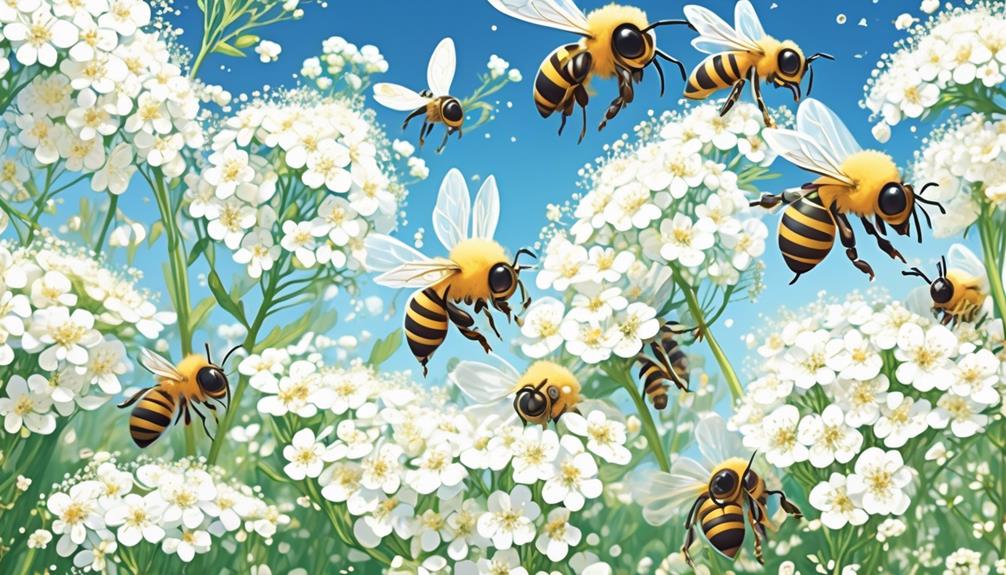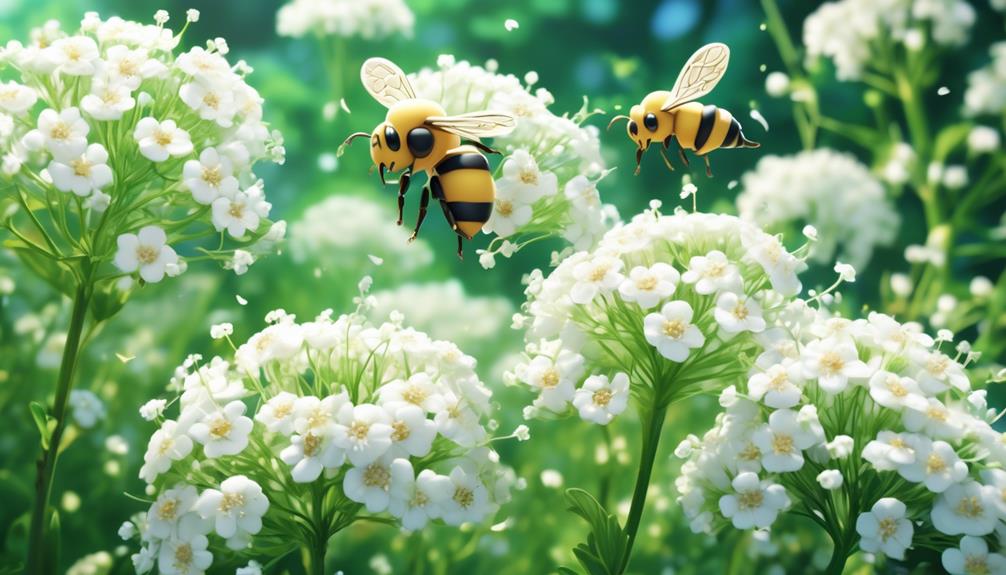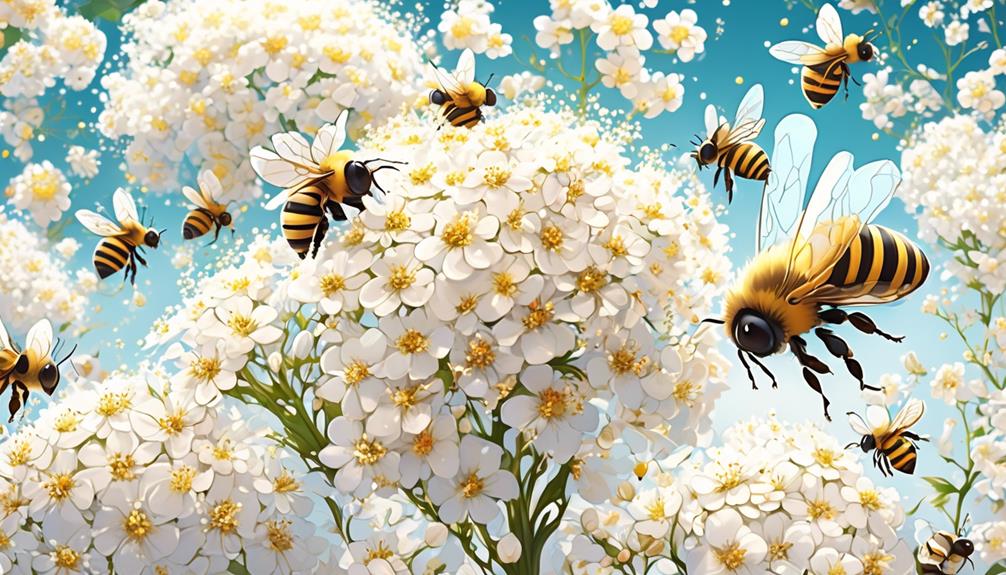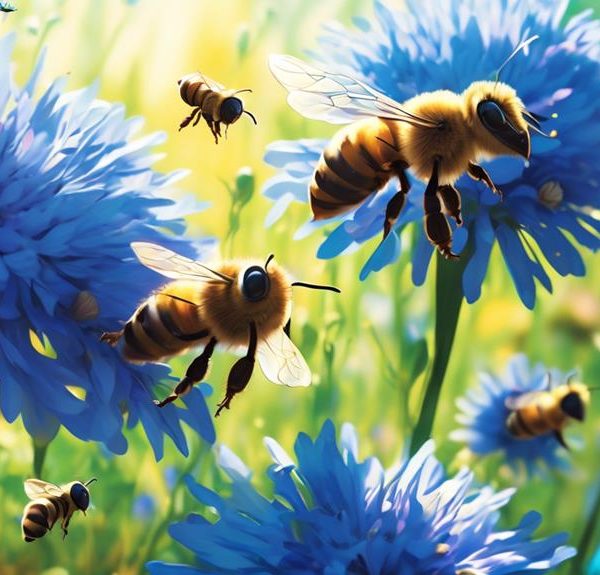Observe the fascinating interplay between bees and Baby's Breath, a mystery that unveils the allure of this delicate garden bloom.

Do Bees Like Baby's Breath
Just as a compass needle points north, you may find yourself drawn to the delicate clusters of Baby's Breath in your garden, wondering if bees share your attraction.
With its symbolic representation of everlasting love and purity, Baby's Breath, or Gypsophila, is not only a staple in floral arrangements but also a common sight in many gardens.
But does this plant, with its tiny, star-like blossoms, hold the same appeal for our buzzing friends?
Let's embark on this journey of discovery together, as we uncover the relationship between bees and Baby's Breath, and find out if these flying pollinators find it as irresistible as we do.
Key Takeaways
- Bees are attracted to flowers based on their shape, color, and nectar availability.
- Bright, warm colors like yellow, orange, and red are easily spotted by bees.
- Bees prefer flowers with landing platforms or tubular shapes that accommodate their long tongues.
- Baby's Breath, with its tiny, star-shaped flowers and high nectar production, can attract bees effectively.
Understanding Bees' Preferences

Delving into the world of bees' preferences, you'll quickly discover that these buzzing creatures are picky, often favoring certain flowers over others due to their shape, color, and nectar availability. It's not random; their choices are dictated by evolutionary adaptations that maximize their efficiency in collecting nectar and pollen.
You'll find that bees are particularly attracted to bright, warm colors like yellow, orange, and red. These colors stand out in a garden, allowing bees to spot them from a distance. In contrast, they struggle to see red flowers, as their vision spectrum doesn't include this color. This means if you're planning a bee-friendly garden, you'd do better to choose flowers in shades that bees can easily spot.
The shape of the flower also matters. Bees favor flowers with landing platforms, like daisies, or those with tubular shapes that accommodate their long tongues, like foxgloves. These shapes make it easier for bees to access the nectar.
Lastly, bees will always go where the nectar is. They're particularly drawn to flowers that produce a lot of nectar and pollen, which they use to feed their colonies. Understanding these preferences is the first step in determining whether bees like baby's breath.
Overview of Baby's Breath

Given your understanding of bees' preferences, you might be wondering how the baby's breath plant fits into this equation. Baby's breath, scientifically known as Gypsophila, is a genus of flowering plants in the carnation family. It's native to Eurasia, Africa, Australia, and the Pacific Islands, but it's been widely cultivated worldwide due to its aesthetic appeal.
Characterized by its small, delicate, white or pink flowers, baby's breath is often used in floral arrangements. It's a hardy plant, capable of growing in a range of conditions, from full sun to partial shade. It prefers well-drained soil and is tolerant to drought, making it a versatile addition to any garden.
You'll find that baby's breath blooms in summer, providing a plethora of tiny flowers that create a cloud-like effect. This blooming period coincides with the active season of many bee species, offering a potential source of nectar and pollen. However, the attraction of bees to baby's breath isn't just about timing. The plant's light fragrance, color, and abundance of flowers may also play a role in attracting these pollinators. So, it's essential to consider these factors when determining if bees like baby's breath.
Pollination Process Explained

To fully comprehend why bees might find baby's breath attractive, it's crucial to grasp the mechanics behind the pollination process. This process begins when bees land on a flower to collect nectar and pollen sticks to their bodies. As they move from flower to flower, some of this pollen rubs off onto the stigmas of other blooms, fertilizing them and enabling the production of seeds. This is the essence of pollination, a vital function in the propagation of many plant species.
In the case of baby's breath, their tiny, star-shaped flowers are teeming with nectar and pollen that can entice bees. The bees aren't just attracted to the flowers for their food offerings, but also for their morphology. The small, clustered flowers allow bees to efficiently collect nectar and pollen while simultaneously aiding in their pollination.
Bees and Baby's Breath: A Connection

Understanding the connection between bees and baby's breath, it's important to note that these insects play a pivotal role in the propagation of this plant species. Baby's breath, known scientifically as Gypsophila, relies heavily on bees for pollination. Without these buzzing workers, the plant's ability to reproduce and spread would be significantly limited.
When bees land on the blooms of baby's breath, they're not just seeking out nectar. They're also collecting pollen, which inadvertently sticks to their legs and bodies. As bees move from one flower to another, they transfer this pollen, enabling fertilization and the production of seeds. This cross-pollination process is what allows baby's breath plants to thrive and multiply.
In turn, baby's breath provides bees with nectar, a crucial food source. Its abundant, small flowers are a rich and easy-to-access source of energy for bees. Therefore, the relationship is mutually beneficial: bees get nourishment, while baby's breath gets a helping hand in reproduction.
Attracting Bees With Baby's Breath

If you're hoping to attract bees to your garden, planting baby's breath can be an effective strategy. These tiny white flowers, known scientifically as Gypsophila, aren't only beautiful, but they're also a magnet for bees.
But why does this work? Let's delve into the details. Bees are attracted to baby's breath due to its high nectar production. The plant's small, clustered flowers provide an abundant source of food for bees, making it a prime target for these buzzing pollinators. Moreover, the plant's light color attracts bees as they prefer bright colors.
To maximize the bee-attracting potential of baby's breath, you should consider companion planting. Pairing baby's breath with plants that flower at different times ensures a continuous food supply for bees in your garden. This way, you'll not only attract bees but also encourage them to stay.
However, it's essential to avoid using pesticides on your plants. These chemicals can harm bees and deter them from visiting your garden. Instead, opt for organic gardening practices.
Tips for Bee-friendly Gardening

Building on the idea of using baby's breath to attract bees, there are several other gardening practices you can adopt to create a more bee-friendly environment.
Firstly, plant a variety of flowers that bloom at different times of the year. This will ensure a continuous food source for bees. Consider plants like lavender, foxgloves, and sunflowers, which are known to attract bees.
Secondly, limit or avoid the use of pesticides. These chemicals can harm bees and other pollinators. If you must use them, do so sparingly and never spray on open blooms.
Next, provide a water source. Bees need water just like any other creature. A shallow dish with some pebbles for the bees to land on will work perfectly.
Frequently Asked Questions
What Other Flowers Are Attractive to Bees Besides Baby's Breath?
You're curious about what other flowers bees are attracted to besides baby's breath. Well, bees love a variety of plants.
They're particularly drawn to flowers like lavender, goldenrod, and aster. These plants not only provide nectar, but their colors and fragrances also attract bees.
Don't forget about herbs, either. Bees tend to love mint, oregano, and basil.
Are There Any Types of Bees That Are Particularly Attracted to Baby's Breath?
Yes, there are types of bees particularly attracted to Baby's Breath. For instance, honeybees and bumblebees find this flower irresistible because of its nectar and pollen.
It's crucial for you to understand that not just the flower's beauty appeals to these bees, but also its scent and color.
How Can I Safely Remove Bees if They Become a Nuisance in My Garden?
You're eager to remove bees from your garden without causing harm. Here's how:
First, avoid killing them. Instead, contact a local beekeeper or pest control agency who'll safely relocate the bees.
You can also plant repellent plants like mint or marigold to deter bees. Remember, bees are crucial for pollination, so it's better to coexist if possible.
If there's a serious threat, take professional help to handle the situation.
Are There Any Negative Effects on Bees if They Are Exposed to Baby's Breath for a Long Time?
You're wondering about the impact of prolonged exposure to Baby's Breath on bees.
There's no evidence to suggest that Baby's Breath harms bees. Actually, bees are fond of these flowers as they're a rich source of nectar.
However, if they're sprayed with pesticides, that could pose a risk.
Always ensure you're using bee-friendly methods in your garden. Remember, bees play a crucial role in pollination, so it's important to keep them safe.
Is Baby's Breath Poisonous or Harmful to Other Insects or Pets?
You're likely wondering if baby's breath is harmful to other insects or pets. Generally, it's not considered poisonous. However, if consumed in large amounts, it can cause digestive issues in pets.
As for insects, there's no clear evidence to suggest it's harmful. In fact, many insects are attracted to its blooms.
But remember, it's always best to monitor your pets and local wildlife to ensure they're not adversely affected.
Conclusion
In conclusion, bees indeed favor Baby's Breath. Its abundant, small flowers provide plentiful nectar, aiding in pollination.
Planting Baby's Breath in your garden not only adds beauty but also contributes to bee conservation. By understanding their preferences and the pollination process, you can create a bee-friendly garden.
So, go ahead, spruce up your garden with Baby's Breath and help our buzzing friends thrive.



